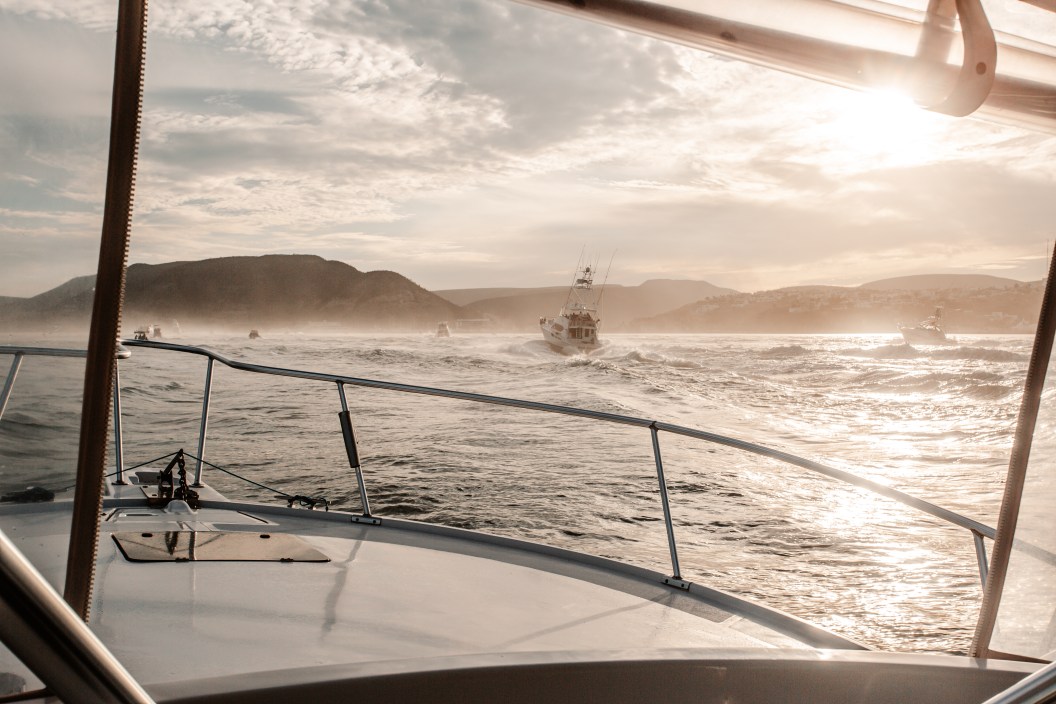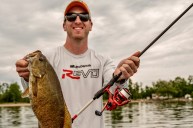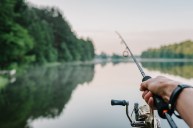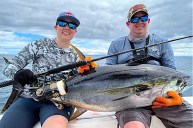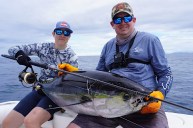It's just past 6 in the morning in La Paz, Baja California Sur, and 143 teams have gathered to fish the MAJA El Grande Tournament: a one-day competition with more than $3,047,000 pesos ($182,000 USD) up for grabs. The marina is a swirl of large fishing charters, small local pangas, and hundreds of jersey-clad, keen-eyed anglers, all hoping to get a piece of the purse.
Teams from across the region—and well beyond—have gathered in the misty morning heat of the marina. If boats could pace anxiously, there would be swells rising along the seawall. And there nearly are, anyway, thanks to the weather: A nasty north wind is predicted for today in the Sea of Cortés, and it's already showing signs of picking up in the early-morning hour.
Just as the clock hits 6:30, a whistle blows and we're off. I'm fishing the tournament on board the Plan B, a well-cared-for vessel helmed by Captain Dorian Guzman and owner Tom Goldston. Tom pilots us through the sprint start of hundreds of vessels pushing to get to the fishing grounds first, accelerating out of the marina in a veritable storm of wakes, spray, and happy shouts.
The Approach
It's game on, and here in Mexico, fishing tournaments are a serious undertaking. We've been assigned team number 007, which we hope will bring us a little luck throughout the day ahead.
It's not long before we pull past Seagull Island, home to a colony of blue-footed boobies, frigate birds, and—as one would expect—plenty of seagulls.
A load of mackerel was quickly acquired from a local fisherman, and now Tom's busy rigging lures for the day. With practiced hands never stopping their work, he offers up perspective that comes from plenty of time spent on these waters.
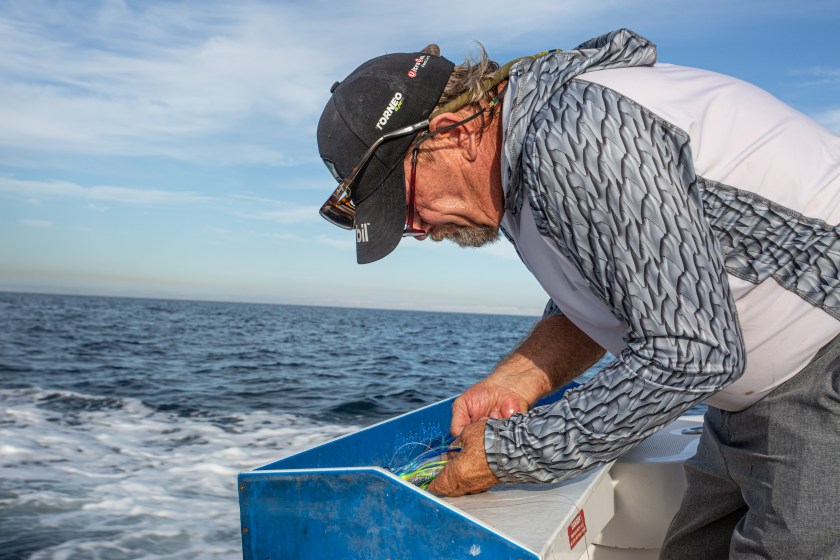
Jess McGlothlin for Wide Open Media
"We've gotta let the fish talk to us," he says. With a long look to the churning horizon ahead and a dose of pragmatic honesty, he adds, "We're gonna get our asses beat in the wind today."
We all know it, though no one's voiced it up until this point. A rough day on a boat still beats a day just about anywhere else, but knowing we're heading into conditions that would have closed the port if not for the tournament, we all know it's going to make for work.
Work that requires fuel: Tom made fish sausage breakfast burritos at home and passes them out now, so we can eat before everything gets salt-sprayed and soaked. Still warm and wrapped in the sort of tortilla one only seems to get in Mexico—bubbly, soft, and just exquisite for something so simple—they're a reminder that simple, fresh food is usually the best, and that everything tastes better on a boat.
A Slow Start
We round a protective corner of land called Coyote Point and face off with the full brunt of the northern wind, which has picked up to above-forecast speeds. To our right lies Baja California Sur, to our left Isla Espirito Santo, a craggy desert island cast in tans and browns—a sharp contrast to the white-capped navy waters rushing underneath our hull.
Captain Dorian is up on the flying bridge, steering us through a world of waves, wind, and spray. Anything that's not tied down is going to go flying, so we secure loose gear and settle in for an inevitably wet ride. But it's not all bad; Baja in summer is hot, and pushes of seawater offer a nice break from the growing heat of the day.
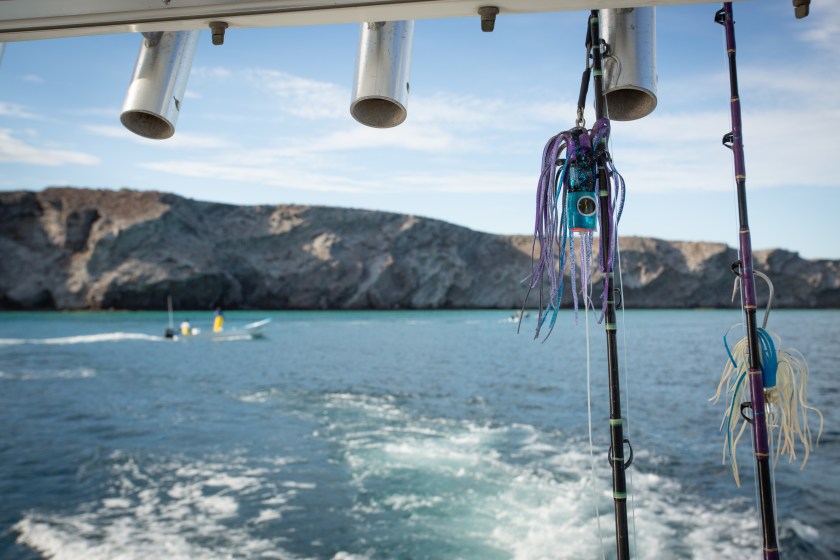
Jess McGlothlin for Wide Open Spaces
Tom has a full spread of lures deployed now, and our attention is focused on the five rods rigged and working. The boat's quiet, the whistle of the wind and crash of the waves broken only by occasional conversation as we listen hopefully for the sound of a buzzing reel.
There's a strange camaraderie that comes from fishing rough seas; a shared mission, shared anticipation, that seems to shorten the getting-to-know-one-another stage. Our team's known each other for less than a day—I've just met Tom and Dorian hours before—yet conversation flows easily when we're not focused on the rods. And when silence falls once more, broken again only by the rush of the wind in our faces and the waves crashing against the hull, it's a companionable quiet.
Frigates swirl to the east, chasing flying fish from wave to wave. We pass a giant loggerhead turtle, swimming along at his own pace in the swell, and wait for the reels to buzz. After a dawn filled with so much anticipation, it's slow. And judging from the radio chatter, we're not the only boat facing an unproductive morning session.
We laugh about the old cliché, "That's why it's called fishing, not catching," and munch on some cold slices of watermelon and jicama as we watch the rods. (If you've never had cold jicama as a boat snack, you're missing out.)
The First Bites
We wait. Maybe start to pray a little. One reel clicks a little. Bump-bump. Tom and I both freeze in our conversation about Tasmanian trout fishing and stare, wondering if it was just the pull of the waves that tugged out a little line. Wait. Watch. And then... zzzziiiinnnggg! The reel's buzzing—we hooked into something.
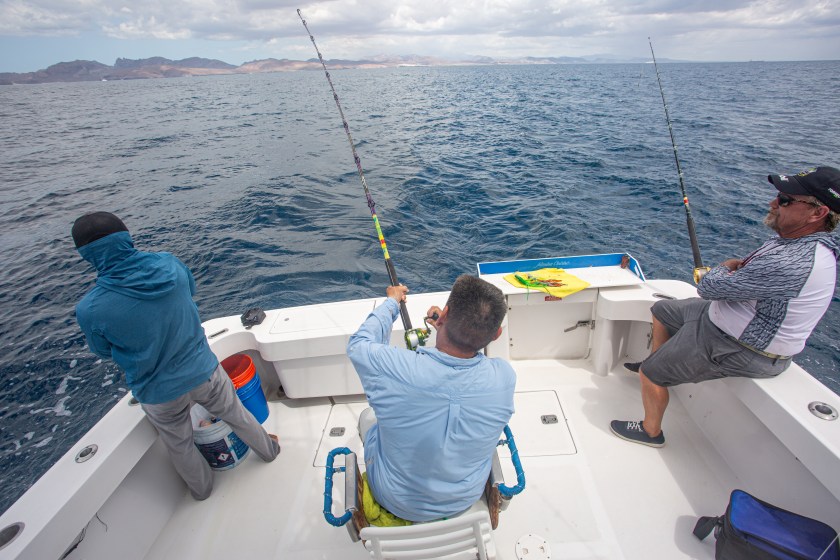
Jess McGlothlin for Wide Open Spaces
We're both thinking the same thing: About damn time.
I jump in the chair with the rod as Tom and friend Victor rush to reel in the other rods. Whatever is on the end of the line, it's not jumping like dorado would, and it doesn't feel huge, but at least it's a fish. Maybe we just need some random little sea-dweller to get things started.
The fish comes in easily enough and turns out to be a little amberjack, ambitious and hungry. He's quickly released and we put the spread back out again. Dorado, a.k.a., mahi mahi, are the goal today—the real players in the tournament. And so, back to work we go.
Playing For Keeps (or Not)
We roll and pitch our way through a sweep between the shoreline and Isla Espirito Santo, then turn around and work a sweep the other direction. Tom and Dorian are constantly finessing our course as we assess the depth finder and the changing terrain beneath the boat. The spread is adjusted, new bait and lures put out. The amount of line changes as we go... we're trying different games to see if we can get a fish to come up and play.
Finally—finally—a reel sings again. Our pulses collectively jump. It's a harder run—a bigger fish! I climb the spray-slick ladder into the flying bridge as fast as safely possible, long-lens camera ready in anticipation of dorado jumps. The Plan B bucks impatiently beneath my bare feet as if in happy approval of the event.
But there are no jumps; no flashes of blue, green, and gold that would signal a dorado is on the end of the line. Instead the fish bulldogs down, going deep and putting up a stubborn fight. When Dorian and I can finally see color, the round silver flash tells us it's not what we're looking for.
The team brings the fish in and there's a collective growl of frustration when we realize it's a toro—"bull" in English—the locals' name for a Pacific jack crevalle. This explains the good fight; jack around the world are an underrated sportfish that are a lot of fun on a rod... just not when it's Tournament Day and we're angling for dorado. And so the toro goes back into the cerulean waters of the Sea of Cortés, and Tom re-rigs us again.
The Last-Ditch Effort
Eventually Dorian steers the Plan B back in the direction of the marina. The tournament ends at four in the afternoon; it's nearly two and we only have a few hours to make a Hail-Mary attempt at putting a dorado in the boat. We head for the Energos Grand, a liquefied natural gas tanker anchored outside the harbor, making a loop around it in the hope fish would have been attracted to the structure. We're not looking for any dorado of size here, not really, but any fish would be a good end to the day.
The move pays off when two rods suddenly start singing. They're not hard, fast runs that would signal a massive fish, but it still means something. We hop on the rods and reel in a few small- to medium-size dorado without trouble.
Everyone grins, simply happy to see that gold-blue-green color combination on the deck, then we quickly release the fish and send them back into the deep blue. Maybe in a few years they'll be big enough to be tournament winners—you never know.
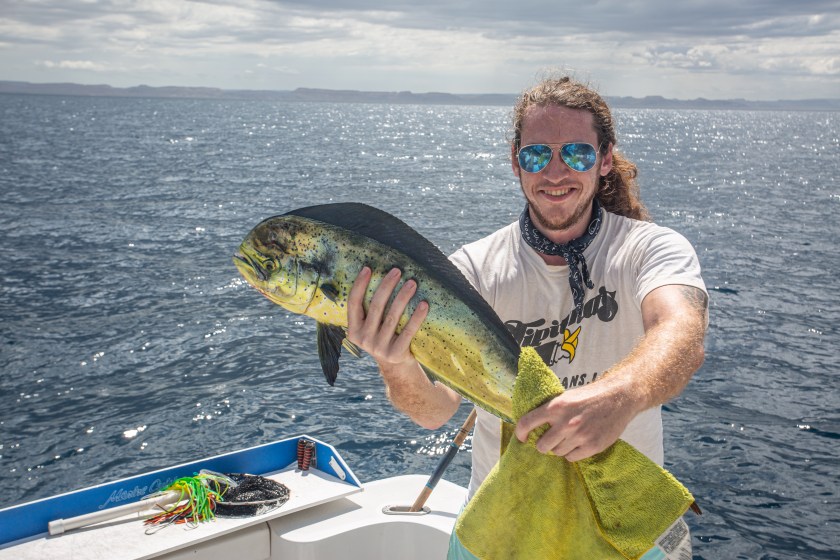
Jess McGlothlin for Wide Open Spaces
Dorado grow quickly—up to 20 pounds in their first year, and up to two or three pounds per month thereafter. Some people estimate they grow as quickly as one to three inches a week in prime conditions.
We head back into the marina, not even bothering to stop at the crowded weigh-in station for the tournament. And we're not the only ones—many of the smaller vessels were forced to come in early due to high winds, and there are a lot of zeroes being posted today.
Lessons from Slow Days on the Water
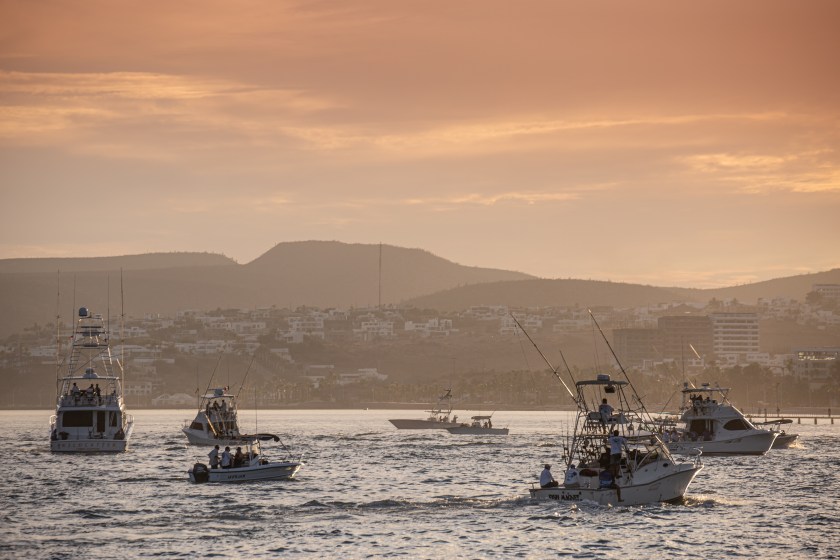
Jess McGlothlin for Wide Open Spaces
I've fished a fair number of tournaments over the years, all fly fishing except for this one. For this career fly angler, this tournament has been a step outside my normal but being new at something is a joy I never hope to lose, especially in such good company.
I don't mind the slow day. That's fishing—slow days are part of it—and instead, the day had been a classroom session on how to manage a boat in rough seas, how to run a spread for dorado, and how to slide up and down a slick flying bridge ladder with camera gear while being pitched around. (Pro tip: I always travel with a waterproof backpack and dry bags for a good reason. Saltwater and cameras are not an ideal combination.)
It's also been a study in a land of contrasts of Baja. The compression of mountains-desert-saltwater landscape is something new to my eye and my brain. The way the desert can change from stark, unforgiving brown to a lush, neon green with one afternoon rainstorm shows the resilience of the place, just as the many oases that dot the desert—interrupting a monochrome landscape with a splash of palm trees, tropical fruit, and freshwater—seem to contrast with the countryside itself. Whatever I'd had in mind before coming to Baja, the place was different. Surprising.
We drop one of our small dorado at Anzuelo Cocina del Mar, a marina-side restaurant, and promise to be back in a few hours for sashimi and fish tacos. There are few things in life as good as eating fresh fish you've caught yourself while sitting wrapped in warm, salt-scented evening air and watching boats rest comfortably in their moorings.
And I know that, even after a few rough days of fishing, I want to come back and delve deeper into this place. Because after a day like today, I want to see what fishing is like when it's "on" and the fish are coming to play.
